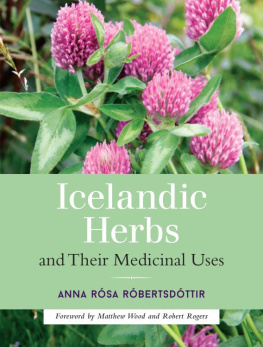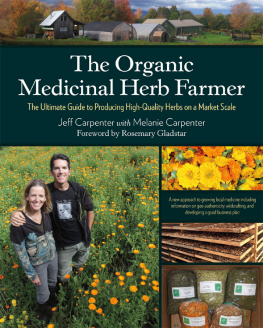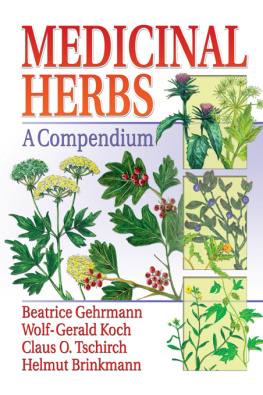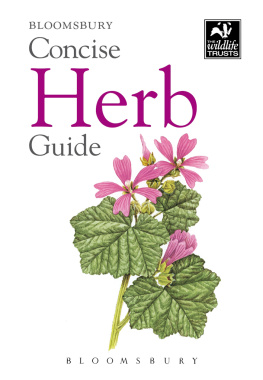Icelandic Herbs
and Their Medicinal Uses
ANNA RSA RBERTSDTTIR
To the reader
This book is intended only to be a guide for self-help and is in no way intended to replace specialist help. The information presented in this book seeks neither to diagnose disease nor to promise a cure.
Readers of this book should not self-diagnose a disease or use the herbs for treating serious or chronic illnesses without seeking advice from a qualified medical herbalist or doctor. Do not use herbs, either internally or externally, without first reading the comments under the heading Warning for each herb where applicable. Do not take larger doses than those that are recommended. Always seek professional advice if symptoms do not disappear after a short time. If the intention is to take herbs simultaneously with medication, seek the advice of a medical herbalist before using the herbs. If herbs are collected for medicinal purposes, make sure that the right herbs are picked and do not pick any rare or protected herbs.
Copyright 2013, 2016 by Anna Rsa Rbertsdttir. All rights reserved. No portion of this book, except for brief review, may be reproduced, stored in a retrieval system, or transmitted in any form or by any meanselectronic, mechanical, photocopying, recording, or otherwisewithout the written permission of the publisher. For information contact North Atlantic Books.
Translated from the Icelandic by Shelagh Smith
All photos Erling lafsson, except Shutterstock.
Published by
North Atlantic Books
Berkeley, California
Cover photo by Erling lafsson
Cover design by Jasmine Hromjak
Icelandic Herbs and Their Medicinal Uses is sponsored and published by the Society for the Study of Native Arts and Sciences (dba North Atlantic Books), an educational nonprofit based in Berkeley, California, that collaborates with partners to develop cross-cultural perspectives, nurture holistic views of art, science, the humanities, and healing, and seed personal and global transformation by publishing work on the relationship of body, spirit, and nature.
North Atlantic Books publications are available through most bookstores. For further information, visit our website at www.northatlanticbooks.com or call 800-733-3000.
Library of Congress Cataloging-in-Publication Data
Anna Rsa Rbertsdttir, author.
[Anna Rsa grasalknir og slenskar lkningajurtir. English]
Icelandic herbs and their medicinal uses / Anna Rsa Rbertsdttir.
p. ; cm.
Translation of Anna Rsa grasalknir og slenskar lkningajurtir: notkun eirra, tnsla og rannsknir. Reykjavk : Anna Rsa grasalknir ehf, 2011.
Includes .
Summary: "A comprehensive guide on Icelandic medicinal herbs, including uses, preparationssuch as infusions, decoctions, tinctures, and syrupsharvesting, and drying."Provided by publisher.
ISBN 978-1-62317-022-6 (paperback) ISBN 978-1-62317-023-3 (ebook)
I. Title.
[DNLM: 1. Plants, MedicinalIceland. 2. PhytotherapyIceland. QV 770 GI3]
RS177.I2
615.3'21094912dc23
2015030994
Contents
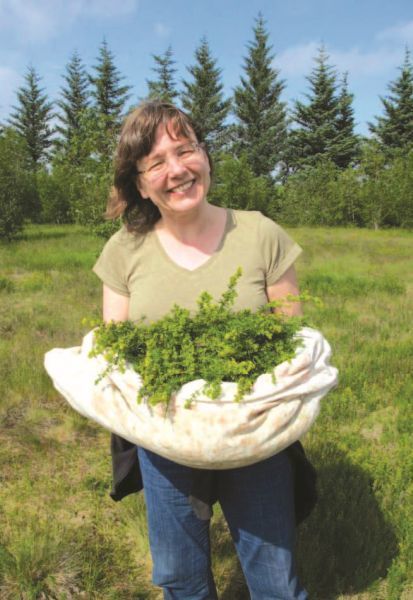
Anna Rsa Rbertsdttir
Photo Erinn Graham
The North Country presents a fascinating biological region. In the southern hemisphere continents are widely spread and plant populations have long been isolated. In the north, on the other hand, the continents are close together. This has created a unique biome where plants from Scandinavia to the tip of eastern Siberia, and on to Alaska, Canada, Greenland, and Iceland, are closely related, nearly identical, actually identical, or can only be separated through genetic profiles. This region also includes the northern British Isles, the European Alps, the Rocky Mountains, and Appalachia. What this means is that the same herbs or very similar cognates are used throughout this enormous region. It also means that an herbal written about the flora of an isolated island in the north Atlantic is pertinent to herbalists almost everywhere in this bioregion.
Another aspect of Northern herbal flora is that there is not so much of it. Unlike the rainforests, where there are thousands of different plant species per acre, in the North Country the sparse amount of flora, the contiguous biological region (supporting cross-pollination), and the short growing season (not supporting as much genetic mutation) have left the plant population smaller (though widespread).
The confluence of these factors means that the herbal folk traditions of these regions depend upon pretty much the same herbs. A Viking in Iceland, a Scottish Highlander, an Aleut medicine man, a Native American medicine woman, a Tyrolean healer, even an occasional Chinese herbalist, and many a Western herbalist, are all going to be using an overlapping selection of medicinal plants.
This is why two herbalists from Minnesota and Alberta find themselves excitedly reading Icelandic Herbs and providing a foreword for the American edition: we use many of the same plants. We have used these plants in the clinic and have compared notes with other herbalists. We are, therefore, excited to know what the herbal medicine of Iceland can teach us: either by supporting established uses, introducing similar but new ideas, or completely new approaches. We thank the authoress for making her tradition available to us in an enjoyable, readable, informative manner.
We have both enjoyed visiting with Anna in person. On a visit to Iceland last summer, Robert had the opportunity to walk with Anna among the wild Angelica, Rhodiola, and Creeping Thyme in the pristine countryside. Sharing traditional plant medicine knowledge with another northern herbalist is truly a blessing and gift.
One final word: there is a big difference between an herbal written by a practicing herbalist and one penned by a journalist. Authenticity rings out in the lines penned by someone who has used the herbs they are discussing. This is the case in Icelandic Herbs.
M ATTHEW W OOD, MS ( H ERBAL M EDICINE), RH ( AHG ) AND R OBERT D ALE R OGERS, BS C, RH ( AHG )
Special thanks go to Erling lafsson for his uniquely beautiful photographs and immeasurable assistance.
Ingrid Markan and Harri have, each in their own way, played a major part in this book and get my best thanks for all their help. Many others were involved in one way or another with the proofreading, and my gratitude goes to all of them for the useful comments and suggestions that I received. Thanks go to Albert Eirksson, sds Ragna Einarsdttir, sds Kradttir, Dagn E. Einarsdttir, Eva G. orvaldsdttir, Eyjlfur Frigeirsson, Gerur Sigtryggsdttir, Gurn Inglfsdttir, Jan Triebel, Jnna Yngvadttir, Mara Bjrg gstsdttir, Shelagh Smith, Steinunn Harardttir, Steinr Sigursson, Sveinn Kjartansson, and runn Steinsdttir.
Special thanks for the English version go to Shelagh Smith and Lowana Veal, both of whom did an excellent job in translating and proofreading.
Iceland is a small country with a population of about 330,000 people and a relatively short history of herbal medicine. The flora of Iceland consists of about five hundred plants, of which eighty-five are medicinal herbs that are discussed in this book. Most of the medicinal plants are not unique to Iceland; they also grow in Europe, North America, and elsewhere in the world. However few of the herbs are not commonly used elsewhere. There are numerous references to medicinal uses of plants in the old sagas of Iceland, but the old texts that are the most accessible nowadays and quoted in this book were published in 1783 and 1830. In these works, the authors often refer to books from Europe, commonly Germany and Norway.

